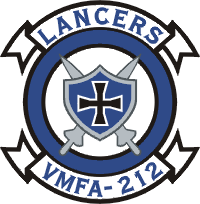
Marine Fighter Attack Squadron 212 (VMFA-212) was a United States Marine Corps F/A-18 Hornet squadron. Most recently known as the "Lancers", the squadron was last based at Marine Corps Air Station Iwakuni, Japan and fell under the command of Marine Aircraft Group 12 (MAG-12) and the 1st Marine Aircraft Wing. Due to a re-organization within Marine aviation, the squadron was deactivated in 2008. It is scheduled to be reactivated as an MV-22B squadron in 2019 under MAG 26 at MCAS New River, NC.

Marine Fighter Attack Squadron 112 (VMFA-112) is a reserve United States Marine Corps McDonnell-Douglas F/A-18 Hornet squadron. The squadron is based at NASJRB Fort Worth, Texas and falls under the command of Marine Aircraft Group 41 (MAG-41), 4th Marine Aircraft Wing. Their tail code is MA. During World War II the squadron saw extensive action throughout the Pacific Theater of Operations especially at the Battle of Guadalcanal as part of the Cactus Air Force. By the end of the war, its 140 air-to-air kills ranked it third among Marine Corps squadrons.

Marine Fighter Attack Squadron 323 (VMFA-323) is an aircraft carrier-based aviation squadron of the United States Marine Corps. The squadron is equipped with the McDonnell Douglas F/A-18C Hornet and is based at Marine Corps Air Station Miramar, California, United States. It falls under the command of Marine Aircraft Group 11 (MAG-11) and the 3rd Marine Aircraft Wing but deploys with the U.S. Navy's Carrier Air Wing 17 (CVW-17).
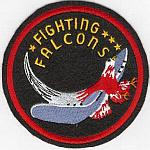
Marine Fighting Squadron 221 (VMF-221) was a reserve fighter squadron of the United States Marine Corps. Originally commissioned during the World War II, it flew the Brewster F2A-3, and after reconstitution in 1943, the F4U Corsair. The squadron, also known as the “Fighting Falcons”, is most notable for its actions on June 4, 1942, during the Battle of Midway, which resulted in 23 members of the squadron, many posthumously, being awarded the Navy Cross for their actions in combat. VMF-221 ended World War II with 185 air-to-air victories, the second most of any Marine Fighting Squadron in the war.
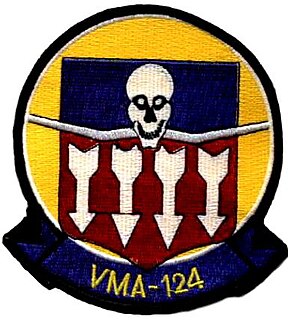
Marine Fighter Attack Squadron 124 (VMFA-124) was a flying squadron in the Marine Forces Reserve based out of Naval Air Station Memphis flying the A-4 Skyhawk. They were part of Marine Aircraft Group 42 and were decommissioned on 19 June 1999. The squadron was the first Marine squadron to fly the F4U Corsair during World War II and also one of the first Marine squadrons to be based on an aircraft carrier. They were known as the “Wild Aces” and ended World War II with 78 air-to-air victories against Japanese aircraft.

Marine Fighting Squadron 313 (VMF-313) was a reserve fighter squadron in the United States Marine Corps. They were a part of the 4th Marine Aircraft Wing and stationed at Naval Air Station New York. Also known as the “Lily Packin' Hellbirds” and the "Lilly Packin' Death Falcons", they fought in World War II mainly during the Philippines Campaign, 1944-45. The squadron was decommissioned in the 1950s.

Marine Fighter Attack Squadron 351 (VMFA-351) was a fighter squadron in the Marine Forces Reserve. The squadron was based at Naval Air Station Atlanta and participated in action during World War II and was decommissioned in 1975.

Marine Fighter Attack Squadron 334 (VMFA-334) was a United States Marine Corps fighter squadron. Known as the “Falcons”, it was part of Marine Aircraft Group 15 and Marine Aircraft Group 33. The squadron participated in action during World War II and the Vietnam War and was decommissioned in 1971.
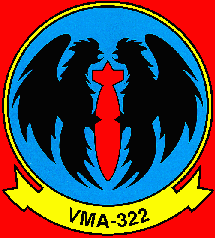
Marine Attack Squadron 322 (VMA-322) was an attack squadron in the United States Marine Corps. The squadron, also known as the “Fighting Gamecocks”, fought in World War II and later became a part of the Marine Forces Reserve based out of Naval Air Station South Weymouth, Massachusetts.
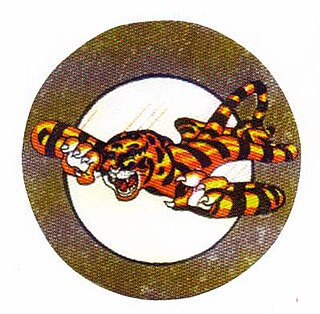
Marine Fighter Squadron 911 (VMF-911) was an aircraft squadron of the United States Marine Corps during World War II. Known as the “Devilcats”, it served as a training squadron during the war, and was deactivated in early 1946.

Marine Fighting Squadron 216 (VMF-216) was a fighter squadron of the United States Marine Corps during World War II. Known as the “Bulldogs”, they flew the F4U Corsair and participated in numerous combat engagements in the Pacific Theater. They were deactivated on March 10, 1945 and remain in an inactive status today.
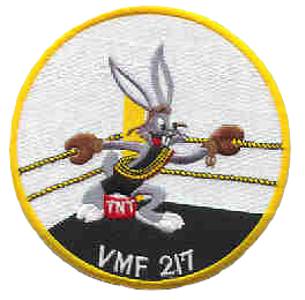
Marine Attack Squadron 217 (VMA-217) was a fighter squadron of the United States Marine Corps that was activated and fought during World War II. Known as “Max’s Wild Hares”, they fought in many areas of the Pacific War including the Battle of Iwo Jima. Following the surrender of Japan, the squadron was deactivated on March 10, 1946. They were briefly reactivated as part of the Reserves but were again deactivated in 1964 and remain in an inactive status today.

Marine Fighting Squadron 215 (VMF-215) was a fighter squadron of the United States Marine Corps that was commissioned and fought during World War II. Known as "The Fighting Corsairs", the squadron fought in many areas of the Pacific War, including the Battle of Bougainville. During its four-and-a-half month tour, the squadron was credited with shooting down 137 enemy aircraft, fourth most in Marine Corps aviation history.

Marine Fighting Squadron 222 (VMF-222) was a fighter squadron of the United States Marine Corps that was activated and fought during World War II. Known as “The Flying Deuces”, they fell under the command of Marine Aircraft Group 14 (MAG-14) and fought in many areas of the Pacific War, including the Philippines campaign (1944–45) and the Battle of Okinawa. During the war, the squadron was credited with shooting down 53 enemy aircraft and was the sister squadron to VMF-215. They were deactivated on December 31, 1949.
Marine Fighting Squadron 413 (VMF-413) was a fighter squadron of the Marine Forces Reserve during the Cold War. It descended from bombing squadron VMB-413, which was the Marine Corps' first medium bomber squadron and had fought during World War II. Best known as “Night Hecklers” and the “Shamrocks”, the squadron fought in many areas of the Pacific War.

Marine Fighting Squadron 511 (VMF-511) was a fighter squadron of the Marine Corps and Marine Forces Reserve during World War II and the Cold War which flew aircraft types such as the F6F Hellcat, F4U Corsair, and the F-8 Crusader. They were originally activated during World War II and fought during the Battle of Okinawa and the Battle of Balikpapan (1945). They specialized in close air support and during the course of the war were credited with only one plane shot down.

Marine Fighting Squadron 441 (VMF-441) was a fighter squadron of the Marine Forces Reserve during the Cold War. They were originally activated during World War II and fought during the Battle of Okinawa. Nicknamed "The Blackjacks", they were credited with 49 planes shot during the course of the war.
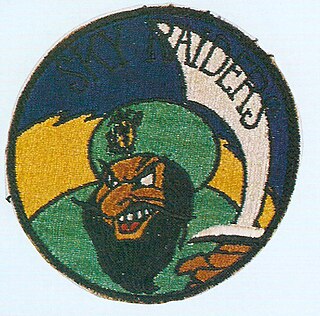
Marine Fighting Squadron 452 (VMF-452) was a fighter squadron of the United States Marine Corps that was commissioned and fought during World War II. Known as the “Sky Raiders”, they flew the F4U Corsair, and the Grumman TBF Avenger, fell under the command of Marine Carrier Group 5 (MCVG-5) and fought in the Battle of Okinawa. The squadron is best known for being aboard the USS Franklin (CV-13) when she was severely damaged by Japanese kamikaze planes of the coast of Okinawa on March 19, 1945. VMF-452 was deactivated on December 31, 1949 and has remained in an inactive status since.
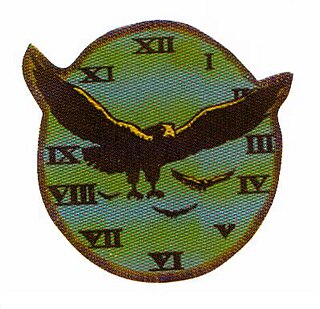
Marine Attack Squadron 543 (VMA-543) was an aviation unit of the United States Marine Corps. The squadron, also known as the “Night Hawks”, were part of the Marine Forces Reserve and were based at Naval Air Station Glenview, Illinois until their deactivation on April 1, 1974. Originally activated during World War II, they fought in the Battle of Okinawa as part of the Tactical Air Force. The squadron was credited with downing 15 Japanese aircraft during the war. Following the surrender of Japan, the squadron was deactivated only to be later reactivated as part of the Reserves. They were again deactivated in 1974 and remain in an inactive status today.




















